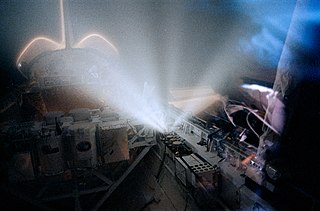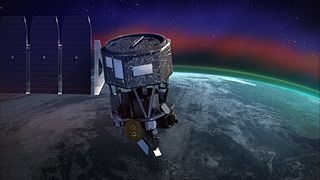
The George C. Marshall Space Flight Center (MSFC), located in Redstone Arsenal, Alabama, is the U.S. government's civilian rocketry and spacecraft propulsion research center. As the largest NASA center, MSFC's first mission was developing the Saturn launch vehicles for the Apollo program. Marshall has been the lead center for the Space Shuttle main propulsion and external tank; payloads and related crew training; International Space Station (ISS) design and assembly; computers, networks, and information management; and the Space Launch System. Located on the Redstone Arsenal near Huntsville, MSFC is named in honor of General of the Army George C. Marshall.

STS-39 was the twelfth mission of the NASA Space Shuttle Discovery, and the 40th orbital shuttle mission overall. The primary purpose of the mission was to conduct a variety of payload experiments for the U.S. Department of Defense (DoD).

National Security Space Launch (NSSL) is a program of the United States Space Force (USSF) intended to assure access to space for United States Department of Defense and other United States government payloads. The program is managed by the Assured Access to Space Directorate (SSC/AA) of the Space Force's Space Systems Command (SSC), in partnership with the National Reconnaissance Office.

Pegasus is an air-launched launch vehicle developed by Orbital Sciences Corporation (OSC) and now built and launched by Northrop Grumman. Pegasus is the world's first privately developed orbital launch vehicle. Capable of carrying small payloads of up to 443 kg (977 lb) into low Earth orbit, Pegasus first flew in 1990 and remains active as of 2021. The vehicle consists of three solid propellant stages and an optional monopropellant fourth stage. Pegasus is released from its carrier aircraft at approximately 12,000 m (39,000 ft), and its first stage has a wing and a tail to provide lift and altitude control while in the atmosphere. Notably, the first stage does not have a thrust vector control (TVC) system.

The Boeing X-37, also known as the Orbital Test Vehicle (OTV), is a reusable robotic spacecraft. It is boosted into space by a launch vehicle, then re-enters Earth's atmosphere and lands as a spaceplane. The X-37 is operated by the Department of the Air Force Rapid Capabilities Office, in collaboration with United States Space Force, for orbital spaceflight missions intended to demonstrate reusable space technologies. It is a 120-percent-scaled derivative of the earlier Boeing X-40. The X-37 began as a NASA project in 1999, before being transferred to the United States Department of Defense in 2004. Until 2019, the program was managed by Air Force Space Command.
In aerospace engineering, spin stabilization is a method of stabilizing a satellite or launch vehicle by means of spin, i.e. rotation along the longitudinal axis. The concept originates from conservation of angular momentum as applied to ballistics, where the spin is commonly obtained by means of rifling. For most satellite applications this approach has been superseded by three-axis stabilization.

FalconSAT is the United States Air Force Academy's (USAFA) small satellite engineering program. Satellites are designed, built, tested, and operated by Academy cadets. The project is administered by the USAFA Space Systems Research Center under the direction of the Department of Astronautics. Most of the cadets who work on the project are pursuing a bachelor of science degree in astronautical engineering, although students from other disciplines join the project.

United Launch Alliance, LLC, commonly referred to as ULA, is an American aerospace manufacturer, defense contractor and launch service provider that manufactures and operates rockets that launch spacecraft into Earth orbit and on trajectories to other bodies in the Solar System. ULA also designed and builds the Interim Cryogenic Propulsion Stage for the Space Launch System (SLS).
The Space Test Program (STP) is the primary provider of spaceflight for the United States Department of Defense (DoD) space science and technology community. STP is managed by a group within the Advanced Systems and Development Directorate, a directorate of the Space and Missile Systems Center of the United States Space Force. STP provides spaceflight via the International Space Station (ISS), piggybacks, secondary payloads and dedicated launch services.

C/NOFS, or Communications/Navigation Outage Forecasting System was a USAF satellite developed by the Air Force Research Laboratory (AFRL) Space Vehicles Directorate to investigate and forecast scintillations in the Earth's ionosphere. It was launched by an Orbital Sciences Corporation Pegasus-XL launch vehicle at 17:02:48 UTC on 16 April 2008 and decayed on 28 November 2015.

Minotaur IV, also known as Peacekeeper SLV and OSP-2 PK is an active expendable launch system derived from the LGM-118 Peacekeeper ICBM. It is operated by Northrop Grumman Space Systems, and made its maiden flight on 22 April 2010, carrying the HTV-2a Hypersonic Test Vehicle. The first orbital launch occurred on 26 September 2010 with the SBSS satellite for the United States Air Force.

Radio Aurora Explorer (RAX) is the first National Science Foundation sponsored CubeSat mission. The RAX mission is a joint effort between SRI International in Menlo Park, California and the University of Michigan in Ann Arbor, Michigan. The chief scientist at SRI International, Dr. Hasan Bahcivan, led his team at SRI to develop the payload while the chief engineer, Dr. James Cutler, led a team of students to develop the satellite bus in the Michigan Exploration Laboratory. There are currently two satellites in the RAX mission.

Fast, Affordable, Science and Technology Satellite-Huntsville 01 or FASTSAT-Huntsville 01 of the NASA. FASTSAT-HSV 01 was flying on the STP-S26 mission - a joint activity between NASA and the U.S. Department of Defense Space Test Program, or DoD STP. FASTSAT and all of its six experiments flying on the STP-S26 multi-spacecraft/payload mission have been approved by the Department of Defense Space and Experiments Review Board (USA-220).

A number of space tethers have been deployed in space missions. Tether satellites can be used for various purposes including research into tether propulsion, tidal stabilisation and orbital plasma dynamics.

Space tethers are long cables which can be used for propulsion, momentum exchange, stabilization and attitude control, or maintaining the relative positions of the components of a large dispersed satellite/spacecraft sensor system. Depending on the mission objectives and altitude, spaceflight using this form of spacecraft propulsion is theorized to be significantly less expensive than spaceflight using rocket engines.
The EELV Secondary Payload Adapter (ESPA) is an adapter for launching secondary payloads on orbital launch vehicles.

Ionospheric Connection Explorer (ICON) is a satellite designed to investigate changes in the ionosphere of Earth, the dynamic region high in our atmosphere where terrestrial weather from below meets space weather from above. ICON studies the interaction between Earth's weather systems and space weather driven by the Sun, and how this interaction drives turbulence in the upper atmosphere. It is hoped that a better understanding of this dynamic will mitigate its effects on communications, GPS signals, and technology in general. It is part of NASA's Explorer program and is operated by University of California, Berkeley's Space Sciences Laboratory.
USA-221, also known as FalconSat-5, is an American military minisatellite, which was launched in 2010. The fifth FalconSat spacecraft to be launched, it carries four technology development and ionospheric research experiments. The satellite was constructed and is operated by the United States Air Force Academy.

The Green Propellant Infusion Mission (GPIM) was a NASA technology demonstrator project that tested a less toxic and higher performance/efficiency chemical propellant for next-generation launch vehicles and CubeSat spacecraft. When compared to the present high-thrust and high-performance industry standard for orbital maneuvering systems, which for decades, have exclusively been reliant upon toxic hydrazine based propellant formulations, the "greener" hydroxylammonium nitrate (HAN) monopropellant offers many advantages for future satellites, including longer mission durations, additional maneuverability, increased payload space and simplified launch processing. The GPIM was managed by NASA's Marshall Space Flight Center in Huntsville, Alabama, and was part of NASA's Technology Demonstration Mission Program within the Space Technology Mission Directorate.

SpaceX CRS-27, also known as SpX-27, was a Commercial Resupply Service mission to the International Space Station (ISS) launched on 15 March 2023. The mission was contracted by NASA and was flown by SpaceX using Cargo Dragon C209. This was the seventh flight for SpaceX under NASA's CRS Phase 2.
















